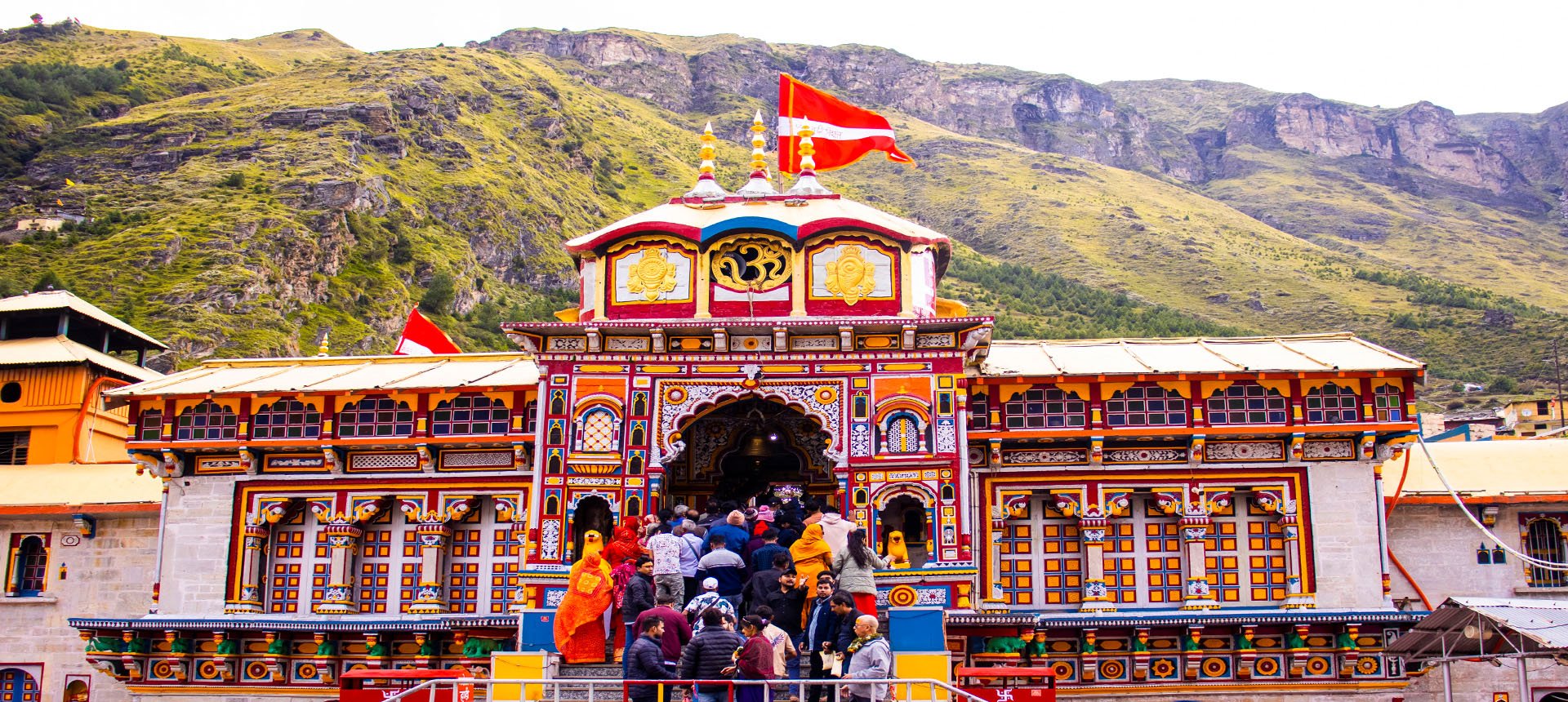
Do Dham Yatra is the second best option for devotees with a time restraint. Unlike the Char Dham Yatra (Yamunotri, Gangotri, Kedarnath, and Badrinath), the Do Dham Yatra takes you to two Dhams. They are Kedarnath and Badrinath Dham. Likewise, the journey thus shortens to 7 nights and 8 days.
Hindu devotees, with Lord Vishnu and Lord Shiva in their hearts, go on this pilgrimage with hopes of attaining salvation.
The journey map includes the following relevant markers (Dhams):
Delhi → Haridwar → Kedarnath → Badrinath → Haridwar → Delhi
This journey takes you from Haridwar and leaves you back at Haridwar. Many devotees find it a perk as they have their fair share of Holy River Ganga’s darshan. The route markers are not the only relevant places you'll visit and stay at. Here's a walk-through of other places you'll visit:
Delhi → Haridwar → Sitapur ↔ Kedarnath → Pipalkoti ↔ Badrinath → Haridwar → Delhi
The trip has more relevant details that you can find in the day-wise Do Dham Yatra itinerary below. If any doubts remain, contact us here.
The day starts when you meet our associate at the given destination in Delhi. The next step is to board the taxi from Delhi to Haridwar. The drive is fascinating as you witness Delhi's hustle disappearing, slowly turning into serene landscapes of the hills. On this 240 km drive, you see the River Ganges, Patanjali Yogpeeth, Amarpur Ghat, etc. This 5 hrs (approx.) journey, will bring you to a well-deserved rest at Haridwar. You get much-needed time for your Do Dham Yatra, starting tomorrow.
The day will start with you, meeting our representative at Haridwar, early in the morning. There, after a small introduction, you board a taxi for Sitapur. Driving through the spilling roads, lined with pines, along river Ganga and Alakhnanda, you reach Sitapur by evening. After the hotel check-in, you can explore Sitapur or rest for the trek tomorrow. Tomorrow is a big day, especially with the 22 km long trek.
There are many temples on your way to Sitapur. They are Mata Dhari Devi Temple, Shree Vishwanath Temple Guptkashi, Shree Kamaleshwar Mahadev Temple, Raj Rajeshwari Mandir, Vashishth Gufa Temple, etc. On the way to Sitapur, you will also encounter Triveni Ghat, Rudraprayag, Rishikesh, Devprayag, Srinagar, Ukhimath, etc.
Your morning starts with a light walk (700 m) from Sitapur to Sonprayag taxi stand. Here, you board taxis for Gaurikund, which is a 6 km drive from Sonprayag. At Gaurikund, devotees have two options;
Kedarnath Dham tests your patience and perseverance to get the darshan (view) of Lord Shiva’s idol. After stops and light snacking at some intervals, you eventually reach Kedarnath Dham, at the right time for evening aarti (prayer). The Kedarnath Temple lights majestically, in the evening’s hue, giving you a one-in-a-million chance to look at Kedarnath Dham.
Kedarnath Dham, apart from its religious significance, is also famous for its placement amidst the Garhwal Himalayan Ranges. The Dham’s backstory is one of Lord Shiva’s trials of the Pandavas’ intentions. He wanted to test their patience and perseverance and the Dham's location continues to do so at present.
Pandavas built Kedarnath to worship the back hunch of Lord Shiva in a bull's disguise. This along with 4 other Lord Shiva temples in Uttrakhand make Panch (5) Kedar. Lord Shiva is the Destroyer, in Hindu Mythology. He destroys to make way for more creation and by destroying the inner demons of the devotees, he helps them turn a new leaf.
Once the evening aarti is done, you'll all retire to camps or dormitories after dinner at Kedarnath.
It's the day for Kedarnath Dham Darshan, you wake up early in the morning and take a bath. After soaking in the divinity of Lord Shiva, have your breakfast and descend to Gaurikund. For devotees with walking-related issues, mules and horses are available.
The descent brings you views of mountains that you will cherish for a lifetime. Other than that, the whole idea of this day is to trek down to Gaurikund, take a taxi to Sonprayag, and walk to Sitapur. The evening will call for a hotel check-in, where you have dinner and retire for the night.
The day begins with your breakfast, then boarding a taxi to Pipalkoti. During this 150 km drive, we will make a stop somewhere for lunch. Afterwards, the next stop is Pipalkoti, where you will be assisted with hotel check-in. You can now rest or explore Pipalkoti, before dinner and eventually rest for tomorrow's journey to Badrinath.
The nights you'll stay at Pipalkoti are 2, one upon reaching Pipalkoti, and one after coming back from Badrinath. The journey from Sitapur to Pipalkoti will give you many watch-worthy spots like Ukhimath, Makkumath, Sari, Koteshwar, etc. Other temples that fall mid-way are Shri Gopinath Temple, Tungnath Temple, and Shree Jageshwar Mahadev Mandir.
The day starts early and after breakfast and check-out, you will drive to Badrinath Dham. At Badrinath Dham, everyone will line up for the darshan (view) of the black Vishnu idol; one of the Swayamvyakt Shetras. Badrinath temple is the shrine for the Hindu god, Lord Vishnu: The ‘Protector.’ Devotees who come visit here, have a desire to keep their lives functioning smoothly. Who can better help with that than the Protector? Lord Vishnu takes care of what happens around the world and devotees seek his blessings for their lifetime.
Badrinath Dham has two stories of origin, each one better than the other. In one story, Maa Lakshmi (Lord Vishnu’s wife) comes to his rescue as a Badri tree. She gives him shade from the sun while he continues his Tapasya (penance). In the other story, the incarnations of Lord Vishnu, Nar, and Narayana lived at Badrinath Dham. The Dham was their ashram, which was later re-established by Adi Shankaracharya, who also elected it one of the Char Dhams around India.
Badrinath is not only about the Dham, it has other places that devotees reminisce about. The most special of them all is Mana Village wherein you have the Last Tea Shop, Vasundhara Fall, Vyas Gufa, BhimPul, and a mesmerizing sight of the Saraswati River. Mana village is equally famous for its woolen products like ashan, carpets, mufflers, shawls, caps, pankhi, etc.
Lastly, when you return to Pipalkoti, your Do Dham Yatra is complete. Now, rest and have dinner at Pipalkoti.
The day starts with a comfortable drive to Haridwar from Pipalkoti. Your day begins with breakfast and then boarding the taxis to Haridwar. The way there is laced with natural beauty, pine and deodar trees, and spiraling roads.
Other than this, you have many sites of importance where you can make a stop. These include Gopeshwar, Karnaprayag, Rudraprayag, Srinagar, Devprayag, Rishikesh, and Nandaprayag. The road also has some temples like Dhari Devi Temple and Vashishta Gufa Temple. In Haridwar You will stay at the hotels or homestays booked by us. You can spend the rest of your day resting or choose to explore Haridwar.
You will return to Delhi today, escorted by our travel associate by a taxi. The journey will take 5 hrs, enough time to rest and reminisce the memories of your Yatra; Kedarnath, and Badrinath. For someone who's not a resident of Delhi, you also have a day to explore some of Delhi; the capital of India.
The main god worshiped at Badrinath temple is Lord Vishnu. The Badarinarayana Temple is located 323 km away from Dehradun, Uttarakhand. This temple is among the 108 Divya Desams that are in dedication to Lord Vishnu.
Kedarnath Dham holds its special status because of several reasons. The temple being dedicated to Lord Shiva (The Destroyer) is amongst the most common reasons. Other reasons include Kedarnath Dham being part of the Char Dham Yatra within Uttarakhand i.e., the Chota Char Dham Yatra. Pandavas (the five brothers from the Mahabharata epic) having taken part in building this temple, is also the reason for its widespread popularity.
No. Badrinath is not one of the 12 Jyortilingas worshiped by Hindus. It's the shrine for Lord Vishnu, whereas Kedarnath Dham is the 11th Jyotirlinga among the 12 that are present in India.
Yes. Kedarnath temple has a plethora of overnight stay facilities. These include GMVN guesthouses, private Dharamshala, etc. Pilgrims can conveniently lodge and enjoy their visit.
Kedarnath is at a higher altitude when compared to Badrinath. Badrinath is at an altitude of 10,827 ft (3,300 m) while Kedarnath is at an altitude of 11,755 ft (3,583 m).
Kedarnath and Badrinath are 218 km apart from one another. This is the distance by road, if we look at the aerial distance, it condenses to 41 km.
Kedarnath Dham is at an altitude of 3,583 m (11,755 ft). This sort of altitude is where you might experience a shortage of oxygen. It will also vary from person to person, not everyone will be affected by the altitude gain.



